Introduction to the English Bible
Translation
 The
translation of the Bible from its original languages
(Hebrew, Aramaic and Greek), is a complex story. The
process of translation for each language is story in
itself. As the Gospel spread to other lands, the books of
the Bible, both Old and New Testaments were also translated,
some earlier then others.
The
translation of the Bible from its original languages
(Hebrew, Aramaic and Greek), is a complex story. The
process of translation for each language is story in
itself. As the Gospel spread to other lands, the books of
the Bible, both Old and New Testaments were also translated,
some earlier then others.
The English translation compared to other
translations is a relatively late translation. The story
of the English Bible in many ways is similar to the other
translation stories. To under the translation process, the
student needs to be familiar with history and source
documents behind the translation.
Most readers of the English Bible today, are not
aware of the dramatic story behind the book they hold in
their hand. How a collection of books written in Hebrew,
Aramaic and Greek changed Europe and especially England is
taken for granted by many Christians.
By using the story of the English Bible, we can
see how religion, politics and intrigue each played their
part. Although each translation story is unique, each story
involves a process, how a group of people received God’s
Word in their own tongue.
Other Translations
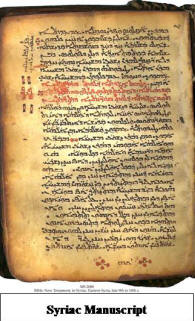
Syriac Versions
The Syriac translation is the Aramaic
translation of the New Testament. The Gospel has an early
history in this region of the world; Antioch and Jerusalem
were the first centers of Christianity. From Syria,
according to Eusebius, an early an early missionary named
Pantaenus in about A.D. 180, took the Gospel to India and
found one of the apostles, Bartholomew had preceded him,
leaving the Gospel of Matthew in Hebrew or Aramaic letters
(Eusebius HE 5.10.2-3).
Prior to the New Testament, the Old Testament
had already been translated into Aramaic in the Jewish
Targums. One of earlier known translations to Syriac is
Tatian’s work called the Diatessaron, meaning through
four. Tatian’s translation was a harmony of the four
Gospels. Tatian founded a group of ascetics in Mesopotamia
called the Encratites who were vegetarians, did not
marry and did not drink alcohol. His views caused his
translation, the Diatessaron to be tainted, for example,
John the Baptist ate milk and honey as opposed to Locust.
The marriage of Joseph and Mary is not mentioned in Matthew
1:18-19.
In the fifth century, the Bishop of Edessa,
Rabbula (411-435) established the Syriac Peshitta. Theodoreus,
bishop of Cyrrhus near the Euphrates (423-457) collected and
removed Tatian’s harmony, Diatessaron, and replaced it with
four separated Gospels.
Coptic Versions
The Coptic language is the language of Egypt, as
opposed to Greek, which was introduced by the armies of
Alexander the Great (333-323 B.C.) and Arabic which the
armies of Islam introduced in the 7th century.
There are two main dialects of Egyptian
Sahidic (Upper Egypt) and Bohairic (Lower
Egypt). The Coptic script is based on the demotic script,
which was derived from the hieroglyphic script.
The Old Testament translation is based on the
Septuagint, the Greek translation of the Old Testament. The
New Testament is based on a translation from the Alexandrian
text.
Armenian Version
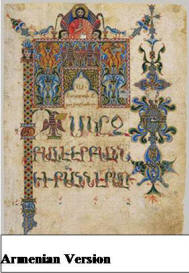
Next to the Latin Vulgate, the Armenian translation of the
Bible has the greatest number of manuscripts, 1,244 numbered
completely or in part. The Armenian version was produced in
the 5th century an Armenian priest, Mesrop
Mashtotz (361-439) who developed the thirty-six letter
Armenian alphabet. Prior to this, all the books written were
in either Greek or Syriac (Aramaic).
The source of the Armenian Bible’s translation
is the Septuagint for the Old Testament and the Syriac
Peshitta.
Old Latin
Before St. Jerome’s translation, the Latin Vulgate, the
Bible in Latin was termed Old Latin. By A.D. 250, Latin was
the language of the Christian scribes and clerics, creating
a need for a Latin Bible. The translation of the Bible into
Old Latin varied among the different versions. These
variations caused Pope Damasus I (345-420) to ask St.
Jerome, a Latin and Greek scholar to revise the Latin
translation of the Bible.
Latin Vulgate
Jerome was commissioned by Pope Damasus I to
revise and standardize the Old Latin version. His
translation became known as the Latin Vulgate, which became
the standard of the Catholic Church for 1000-years after its
completion. By A.D. 383, Jerome completed his translation of
the four Gospels based on the Old Latin, but compared to the
Greek text.
Jerome later translated the Old Testament
directly from the Hebrew, this was completed in 405; his
basis of translation was sense-for-sense rather then
word-for-word. Jerome received a great deal of
criticism because he translated from the Hebrew Old
Testament rather then from the Septuagint.
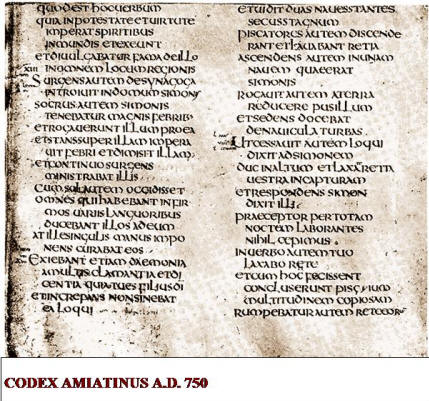
English Translations
Rome conquers the British Isles
The history of the King James Bible starts with
the history of England. The first written record of
England begins with the Roman conquest dating back to the
time of Julius Caesar in 55 BC, recorded in his “Gallic War
commentaries”. He describes his conquest of England with
more then 800 ships. The Celts made peace with Caesar, this
allowed him to leave and manage Gaul (France). This peace
between England and Rome lasted until the reign of the
Emperor Claudius. Rome invaded with 40,000 soldiers and
established its control over the British Isles in A.D. 43.
England became part of the Roman Empire. Today, Hadrian’s
Wall (117-138) marks the northern boundary of Roman
territory.
Christianity in England
With the spread of Christianity in the Roman Empire,
Christianity became the faith of England by the 3rd century,
as missionaries brought the Gospel to the outer parts of the
Empire.
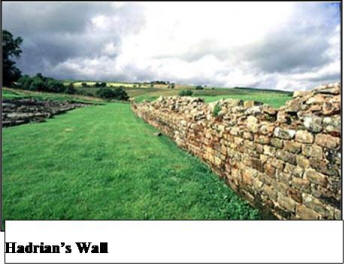 The church in England was well enough established by the
4th century to send three British bishops—of Londinium
(London), Eboracum (York), and Colonia Linum (Lincoln)—to
the Council of Arles (in modern France) in 314. However,
there is no record of the Bible’s translation into the
English language at this point. Latin was the language of
Rome and its various outposts, including England.
The church in England was well enough established by the
4th century to send three British bishops—of Londinium
(London), Eboracum (York), and Colonia Linum (Lincoln)—to
the Council of Arles (in modern France) in 314. However,
there is no record of the Bible’s translation into the
English language at this point. Latin was the language of
Rome and its various outposts, including England.
The Romans withdrew from England in the 5th
century to save the capital, Rome, from invading Germans
tribes. German tribes also invaded the British Isles, two
tribes, the Angles and Saxons swarmed from Germany, in the
process Christianity almost vanished from the Isles. The
Angles and Saxons, German tribes from Saxony; eventually
merged with the Celts and became known as the English.
For the next 1000 years until the time of Henry
VIII (1491-1547), England was part of the Roman Catholic
Church. The Roman Catholic Church dominated both the
political and religious spheres of nations. During this
period portions of scripture were translated in by various
people, Caedmon (A.D. 678) a cowherder turned scripture into
Old English poems, allowing people to memorize and sing
scripture. Aldhelm ( A.D. 709) the bishop of Sherborne,
translated a portion of the Psalms from the Vulgate into
Anglo-Saxon.
Bede, the father of English history, (A.D. 675-735)
translated the Gospel of John into English on his deathbed.
No portion of this translation remains. Alfred the Great
(A.D. 849-901) was a literate king of Wessex from 871, he
encouraged Christianity in his reign. He introduced the law
code, with translations from the Ten Commandments,
Exodus 21-23
and the book of Acts 15:23-29.
For the majority of the people, the Bible was a book only
understood by the educated clergy.
Several factors caused a growing interest in the
Bible, one factor was the schism of the Catholic Church in
1378-1417, known as the Great Schism, causing there to be
two popes, one based in Rome and the other in Avignon,
challenging Papal authority, demonstrated Papal fallibility.
Another factor was the Black Death, the Bubonic
plague that caused the death of 30 to 40% of urban
populations. The plague resurfaced several times in 1360,
1369, 1374 causing the populations to be devastated. Life
expectancy in England dropped to seventeen years of age in
1376 from twenty-five in 1348. All this caused people to
look for answers, causing a revival in religious interest
among the laity. This growing interest in eternal matters
was hindered by the lack of resources.
One of the main issues was the role of the laity
and clergy. The Roman language, Latin, became the language
of the clergy. Most of the laity could not read or
understand Latin. The Bible, the Latin Vulgate, first
translated in the 4th century by Jerome from the Septuagint
and then later from the Hebrew was inaccessible to English
speaking people.
John Wycliffe
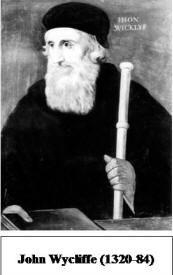 To
remedy the problem of accessibility, John Wycliffe (1320-84)
an oxford scholar, began to translate parts of the Bible
into English. Wycliffe also challenged Roman doctrines,
such as transubstantiation
and the role of the church in national politics. His
students would carry his views to the rest of England,
traveling preachers known as the Lollards (derived from
lowlanders, used in the sense of heretics) He completed the
translation of the New Testament in 1380. Four years after
his death the Old Testament translation was completed by
John Purvey (1354-1428), Wycliffe’s secretary. The basis
Wycliffe’s translation was the Latin Vulgate. Purvey’s
edition became the dominant English translation for almost
200-years.
To
remedy the problem of accessibility, John Wycliffe (1320-84)
an oxford scholar, began to translate parts of the Bible
into English. Wycliffe also challenged Roman doctrines,
such as transubstantiation
and the role of the church in national politics. His
students would carry his views to the rest of England,
traveling preachers known as the Lollards (derived from
lowlanders, used in the sense of heretics) He completed the
translation of the New Testament in 1380. Four years after
his death the Old Testament translation was completed by
John Purvey (1354-1428), Wycliffe’s secretary. The basis
Wycliffe’s translation was the Latin Vulgate. Purvey’s
edition became the dominant English translation for almost
200-years.
The Catholic Church was so opposed to Wycliffe
translating the Bible into the English language that in the
year 1415, the Council of Constance ordered his bones
exhumed and burned, and his ashes to be scattered in the
river Swift. People caught reading the Bible were liable to
loose their land, cattle , life and goods. In 1408, a synod
at Oxford decreed it as unlawful to read Wycliffe’s Bible,
declaring,
It is a dangerous thing….as witnesseth
blessed St. Jerome, to translate the text of the holy
Scripture out of one tongue into another; for in the
translation the same sense is not always easily kept, as the
same St. Jerome confesseth, that although he were
inspired...yet oftentimes in this he erred; we therefore
decree and ordain that no man hereafter by his own
authority… translate any text of the Scripture into English
or any other tongue, by way of a book, pamphlet, or
treatise; and that no man read any such book, pamphlet or
treatise, now lately composed in the time of John Wycliffe
or since or hereafter to be set forth in part or in whole,
publicly or privately, upon pain of greater excommunication,
until the said translation be approved by the ordinary of
the place or, if the case so require, by the council
provincial. He that shall do contrary to this shall
likewise be punished as a favourer of heresy and error.
Still people paid to borrow the Wycliffe bible, with the
price being recorded as a load of hay, to read the Bible an
hour a day over a period
.
In 1455, Johannes Gutenberg invented a printing
press using movable type. Gutenberg’s first work was the
printing of the Bible, the Latin Vulgate. Gutenberg’s
printing became known as the Forty-Two-line Bible,
because of 42-lines in a column. Gutenberg’s invention
solved a major problem for scripture transmission. With the
printing press, human error in text copying was virtually
eliminated. In addition, copies could be made much quicker
and less expensive than hand copies, making books and Bibles
available to the masses.
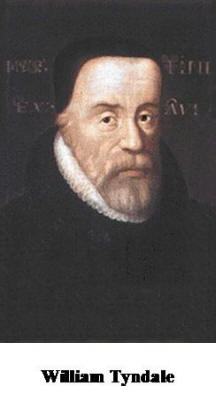 William
Tyndale (1494-1536) Tyndale Translation
William
Tyndale (1494-1536) Tyndale Translation
William Tyndale, a Catholic priest, (1492-1536)
born in Gloucestershire, went to Oxford at the age of
sixteen. After receiving his Master of Arts degree, he
taught at Oxford for a year and then at Cambridge. During
this period, he became aware of the lack of scripture
knowledge amongst the priests and laity. In a debate with an
English priest, Tyndale showed his early desire to make
scripture available to all,
Not long after, Tindall happened to be in the company of a
certain divine, recounted for a learned man, and in
disputing with him drave him to that issue, that the great
doctor burst out into these blasphemous words: “We are
better to be without God’s law than the Pope’s. Master
Tindall, replied, “I defy the Pope and all his laws,” and
added that if God spared him life, ere many years he would
cause a boy that driveth the plough to know more of
Scripture than he did.”
He took on the task of establishing an English translation
of the Bible based on the Hebrew, Aramaic and Greek text.
The first Hebrew Bible was published in 1488, along with the
Hebrew Lexicon in 1506. Tyndale planned to use these for an
English translation of the scripture. Martin Luther
published his German translation in 1522, but Tyndale needed
permission of the church to translate the Bible. The Church
of Rome opposed his plans his plans to translate the Bible
into English.
Tyndale left for Cologne in 1525, but the church
prevented the printer from completing the job, Tyndale
rescued 6000 copies of Matthew chapters 1-22 already printed
and fled to Worms, in Germany. In Worms, he completed two
editions and had them smuggled to England (1525). The
Bishop of London, Cuthbert Tunstall purchased as many copies
as possible and had them burned. Of the 18,000 copies
smuggled only two remain.
Charles V, the Holy Roman Emperor considered
Tyndale a heretic and had him kidnapped in Antwerp, Belgium
and imprisoned. Later found guilty of heresy, Tyndale
removed from his priestly office, was handed over to secular
powers for execution in August 1536. Burning at the stake,
Tyndale cried, “Lord, open the King of England’s eyes”.
This statement would seem prophetic as Tyndale’s version of
the New Testament provided the basis for all successive
versions between his day and ours. The King James Version
is practically a fifth revision of Tyndale’s revision.
The basis of Tyndale’s New Testament was the
Erasmus 2nd or 3rd edition of the
Greek New Testament printed in 1519 and 1522. Tyndale used
the Hebrew Bible and Lexicon to translate portions of the
Old Testament. Miles Coverdale would complete and edit
portions of the Old Testament, after Tyndale’s death. This
became known as the Coverdale translation (1535).
Another of Tyndale’s disciples John Rogers, was
the force behind the Matthew’s Bible (1537), Henry
the VIII allowed the Bible to be distributed throughout
England. This free flow of scriptures caused many
theologians concern. Edward Foxe, complained “The lay people
do now know the holy scripture better than many of us; and
the Germans have made the text of the Bible so plain and
easy by the Hebrew and Greek tongue that now many things may
be better understood without any glosses at all than by all
the commentaries of the doctors”
William Coverdale (1488-1569), The
Great Bible
The atmosphere changed in England as Rome and
Henry the VIII came into conflict. Henry the VII wanted to
divorce his Catholic wife, Katherine of Aragon, the Catholic
Church refused. When the Pope refused, Henry VII renounced
the Catholic Church and appointed himself head of the Church
of England. To spite the Catholic Church and unify his
kingdom, he ordered the Bible printed and translated into
English, and placed in all the churches, the translation
they placed in the churches was the Great Bible. Miles
Coverdale was the editor behind the Great Bible, which used
the Matthew’s Bible as its basis. The size of the Bible, 16
½ inches by 11 inches was the reason it was called the Great
Bible.
The Geneva Bible (1560)
When Mary Tudor (1553-1558) (Daughter of Henry
VIII) became Queen of England, she tried to restore
Catholicism Protestants were persecuted and killed. Many
fled to John Calvin’s Geneva, where another translation of
the English Bible was prepared, the Geneva Bible.
The Geneva Bible translation (1557, 1560) was done under
the direction of William Coverdale and John Knox and
influenced by John Calvin. This Bible became popular in
England after Mary Tudor’s execution and Protestant
persecution stopped. An act of the Scottish Parliament
required it compulsory for every householder who had an
income above a certain amount, to buy a copy of the Geneva
Bible. The popularity of the Geneva Bible with Protestants
caused the Great Bible’s revision. This revised edition
later became known as the Bishop’s Bible (1568).
The marginal notes of the Geneva Bible had a
Calvinist theology, which caused concern for the Church of
England. To counter this concern, Matthew Parker, Archbishop
of Canterbury, who recognized the superior quality of the
Geneva translation, published the Bishop’s Bible in 1568 to
counter its theology.
The Douay-Rheims Bible (New Testament
1582, Old Testament 1609-10)
With the popularity of the Geneva Bible and its
marginal notes, the Catholic Church was forced to respond
with their own English translation. William Allen an Oxford
fellow and strict Catholic, fled to Europe, when Elizabeth I
came to the throne. He established and English College in
Douay, France 1568. The college was later forced to move to
Rheims in 1578, where the New Testament was published. The
college returned to Douay, France in 1593 where the Old
Testament was published, hence the name Douay-Rheims.
The source text used in the translation was the
Latin Vulgate. The translators made their aims clear in the
preface, “To meet the Protestant challenge, priests must
be ready to quote Scripture in the vulgar tongue since their
adversaries have every favorable passage at their fingers’
ends; they must know the passages correctly used by
Catholics in support of our faith, or impiously misused by
heretics in opposition to the Church’s faith”
The apocryphal books are interspersed among the
canon as in the Latin Vulgate.
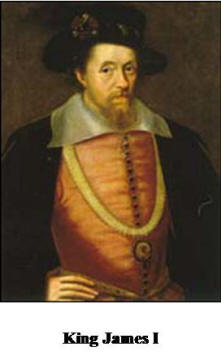
The King James Bible ( KJV 1611)
In 1604, the Puritan Party made a petition to
King James I (1603-1625) called the Millenary Petition,
about grievances between the Puritans and the English
Church. John Reynolds, the Puritan president of Corpus
Christi College, Oxford raised the question of having an
authorized version of the English Bible that would be
acceptable to all parties. This Bible was to replace both
the Bishop’s Bible and the Geneva Bible as the
English translation. The purpose of this new translation was
to have a Bible, that could be read in church services and
at home.
Six companies of men totaling 54 were assigned
with only 47 actually working on the revision of the Bible.
Each committee had a set of instructions. All other English
translations were to be consulted as well as the Hebrew and
Greek Texts but the Bishops Bible was to be used as the base
in translation. Their finished work is known as the King
James Authorized Bible.
The Hebrew Text used was second edition of the
Rabbinic Bible prepared by Jacob ben Chayim published
by Bromberg (1524-1525). The New Testament consulted the
work commonly known as Textus Receptus or the
“Received Text”. Beza’s Greek New Testament of 1565 was the
underlying text of the New Testament used in the King James
Bible, which became known as Textus Receptus. The King
James 1611 translation also became known
by the name Textus Receptus or received text.
King James established the principles for the
translation of the Authorized Version, hence the name
authorized.
1. The 1602 version of the Bishop’s Bible was to be used as
the basis of the translation, but the original Greek and
Hebrew were to be examined. Other translations were also to
be consulted to determine the best reading of the Hebrew and
Greek.
2. So the translation did not become too stilted a variety
of words were to be used for the same Greek and Hebrew
words.
3. Words necessary in English but not in Hebrew or Greek
were to be set in Italics.
4. Names of biblical characters were to correspond as
closely as possible to those in common use; however names
were not standardized. Example Jesus and Joshua.
5. Old Ecclesiastical words were to be maintained,
congregation and washing in the Tyndale’s translation became
“Church” and “Baptism” in the Authorized Version.
6. No marginal notes were to appear other then to explain
the Hebrew and Greek words.
7. Existing chapter and verse divisions were to be retained,
but new headings would be supplied.


 The
translation of the Bible from its original languages
(Hebrew, Aramaic and Greek), is a complex story. The
process of translation for each language is story in
itself. As the Gospel spread to other lands, the books of
the Bible, both Old and New Testaments were also translated,
some earlier then others.
The
translation of the Bible from its original languages
(Hebrew, Aramaic and Greek), is a complex story. The
process of translation for each language is story in
itself. As the Gospel spread to other lands, the books of
the Bible, both Old and New Testaments were also translated,
some earlier then others. 


 The church in England was well enough established by the
4th century to send three British bishops—of Londinium
(London), Eboracum (York), and Colonia Linum (Lincoln)—to
the Council of Arles (in modern France) in 314. However,
there is no record of the Bible’s translation into the
English language at this point. Latin was the language of
Rome and its various outposts, including England.
The church in England was well enough established by the
4th century to send three British bishops—of Londinium
(London), Eboracum (York), and Colonia Linum (Lincoln)—to
the Council of Arles (in modern France) in 314. However,
there is no record of the Bible’s translation into the
English language at this point. Latin was the language of
Rome and its various outposts, including England.  To
remedy the problem of accessibility, John Wycliffe (1320-84)
an oxford scholar, began to translate parts of the Bible
into English. Wycliffe also challenged Roman doctrines,
such as transubstantiation
To
remedy the problem of accessibility, John Wycliffe (1320-84)
an oxford scholar, began to translate parts of the Bible
into English. Wycliffe also challenged Roman doctrines,
such as transubstantiation William
Tyndale (1494-1536) Tyndale Translation
William
Tyndale (1494-1536) Tyndale Translation